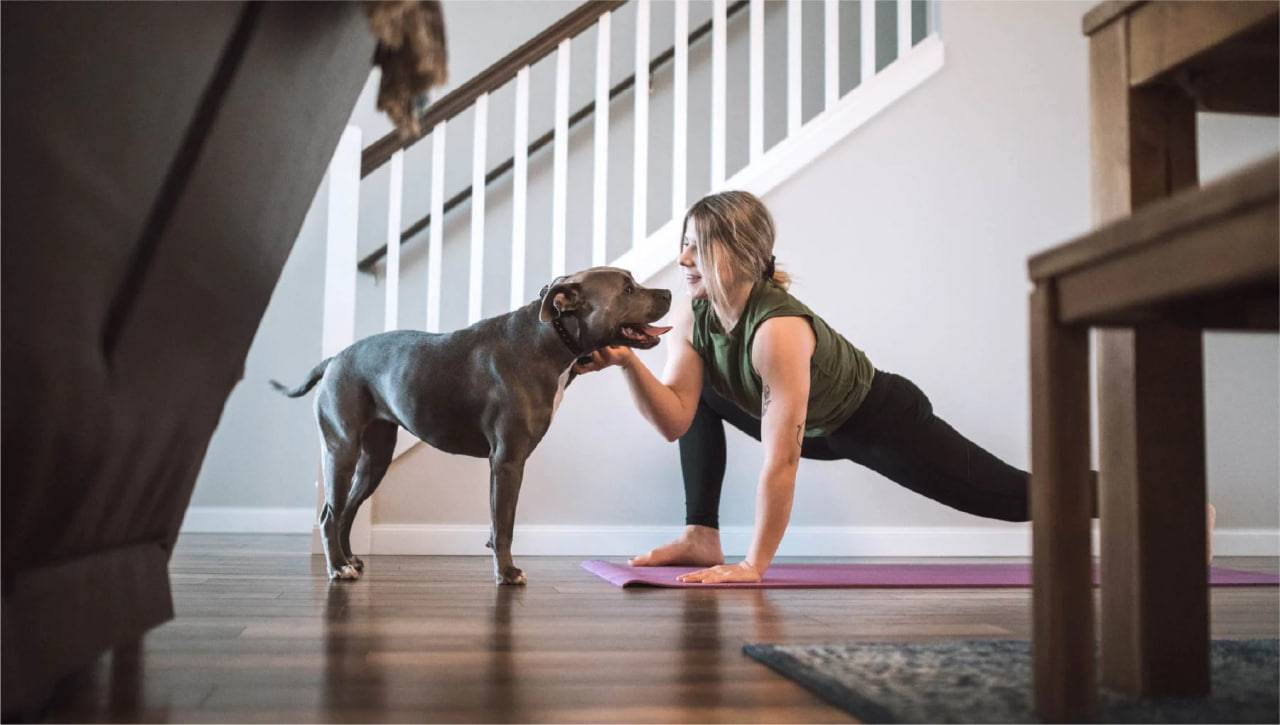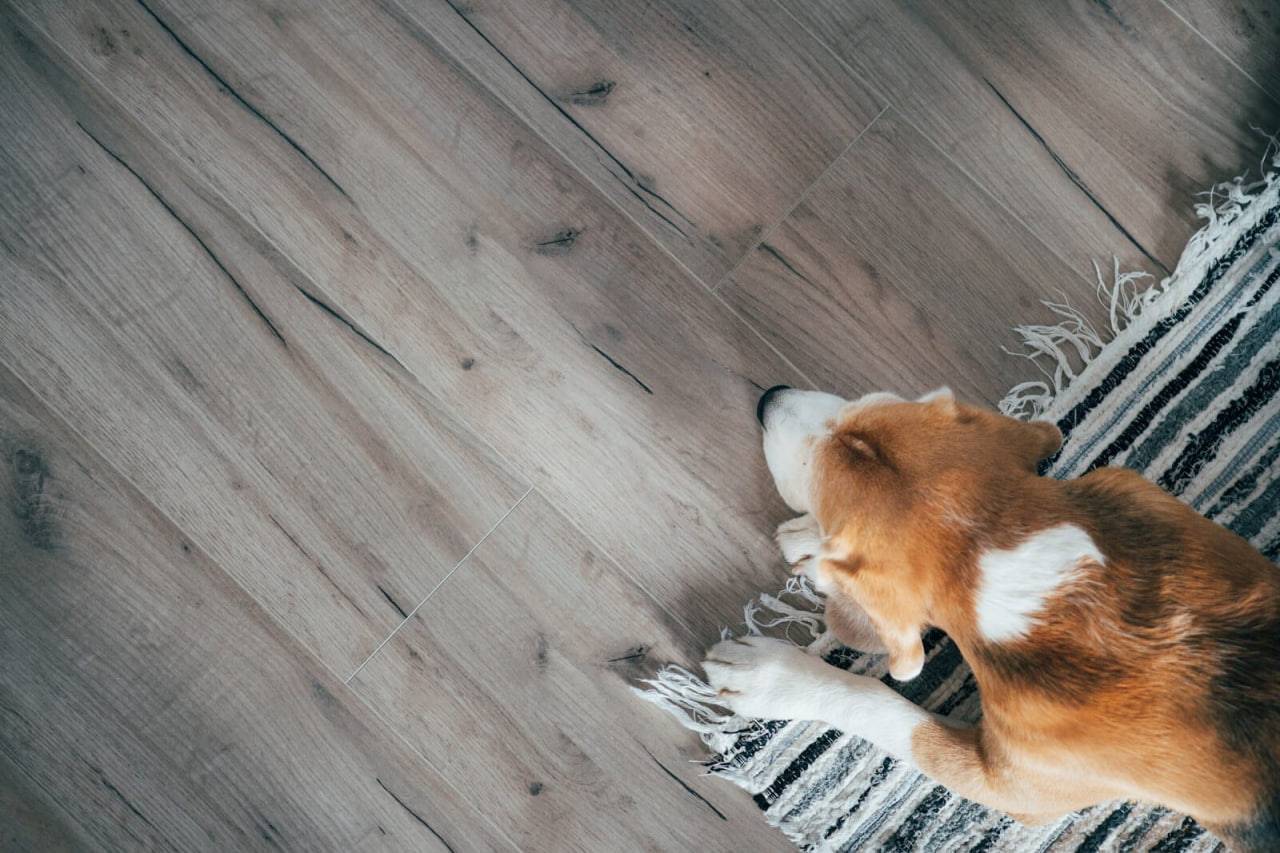While our canine companions bring endless joy, their playful paws can sometimes leave their mark on our floors. But fear not, fellow dog lovers! This guide explores the top choices for dog-friendly hard flooring, along with tips to combat scratches and accidents.
Hard Flooring: The Top Picks for Dog Owners
Although carpets provide a cozy feel, hard flooring reigns supreme for dog households. Here’s why:
- Effortless cleaning: Spills and accidents are a breeze to wipe away, making life easier for you.
- Rug flexibility: You can still add area rugs and cushions for your dog’s comfort and style.
The Ideal Dog-Friendly Floor Checklist:
- Non-slip surface: Ensures safe footing for your furry friend, especially as they age.
- Durable and scratch-resistant: Protects against wear and tear from playful paws.
- Easy to clean: Look for materials that resist stains, mud, and unwelcome surprises.
- Waterproof: Some floors offer complete protection against “accidents,” providing peace of mind.
- Heat compatibility: If you have underfloor heating, ensure your chosen flooring is compatible.
Dog-Friendly Flooring Showdown: Laminate vs. Engineered Wood vs. Luxury Vinyl Tile
Choosing the right flooring for your furry friend can be tricky. Fear not, dog owners! This guide compares three popular contenders: laminate, engineered wood, and luxury vinyl tile (LVT), highlighting their strengths and weaknesses when it comes to our canine companions.
Laminate:
- Pros: Budget-friendly, easy to clean, hides scratches well (depending on the pattern).
- Cons: Not fully waterproof or scratch-resistant, can be slippery (unless textured).
- Verdict: A good value option, but be mindful of potential water damage and slipperiness.
Engineered Wood:
- Pros: Offers the natural beauty of wood at a lower price point than solid wood, easier to install and maintain.
- Cons: Susceptible to scratches and stains, requires regular cleaning to prevent urine damage.
- Verdict: Provides a luxurious look but demands diligent cleaning and may not withstand playful paws unscathed.
Luxury Vinyl Tile (LVT):
- Pros: Completely waterproof, highly scratch-resistant, easy to clean, comes in various styles to mimic wood, stone, or tile.
- Cons: May be slightly more expensive than laminate or engineered wood.
- Verdict: Our top pick – LVT offers the best combination of durability, water resistance, scratch resistance, and style, making it a paw-sitive choice for dog owners.
Ultimately, the best choice for you depends on your budget, lifestyle, and dog’s needs. Consider factors like your dog’s size, activity level, and potential for accidents when making your final decision.
Avoiding Slips and Scratches: Dog-Proofing Your Laminate Floors
Laminate flooring offers convenience and style, but its smooth surface can be problematic for our furry friends. Here’s how to ensure your laminate floor provides a safe and comfortable space for both you and your dog:
Preventing Slips:
- Opt for Textured Laminate: Look for laminates with a textured surface that mimics wood grain. This added texture provides increased traction, preventing slips and falls, especially for senior dogs or excitable puppies.
- Utilize Rugs: Strategically placed rugs in high-traffic areas offer a non-slip alternative for your dog, promoting safety and comfort.
Combating Scratches:
- Choose Higher AC Rating: Select laminate with an Abrasion Class (AC) rating of A3 or higher. This signifies better scratch resistance, making it more resilient to wear and tear from your dog’s nails.
- Regular Trimming: Keeping your dog’s nails trimmed minimizes the likelihood of scratches on the laminate surface.
Addressing Existing Scratches:
- Minor Scratches: For minor scratches, use a wax pencil that matches your laminate’s color. Fill the scratch, then buff the area to blend seamlessly.
- Deeper Scratches: For deeper scratches, consider colored repair putty. Apply the putty, ensuring it dries and hardens completely before allowing your dog back on the floor.
Remember, while laminate can be dog-friendly, it requires some adjustments to create a safe and comfortable environment for your furry companion. By following these tips and choosing the right laminate type, you can create a space where both you and your dog can thrive.
Finding Wood Floors that Work for Your Dog: Beauty and Functionality
The timeless elegance of wood floors is undeniable, but are they a practical choice for dog owners? While wood offers undeniable charm, it requires more maintenance than other options like laminate or vinyl and might not be ideal for playful pups.
Here’s what to consider if you’re set on wood flooring and have a canine companion:
Weighing the Pros and Cons:
- Upsides: Wood floors offer unmatched visual appeal and add natural warmth to your space.
- Downsides: They are susceptible to scratches from dog nails, require more diligent cleaning and upkeep, and might not stand up well to accidents.
Dog-Friendly Wood Flooring Choices:
- Harder Wood Species: Opt for woods like hickory or oak, known for their superior hardness and scratch resistance compared to softer woods like pine or cherry.
- Lighter Colors: Lighter shades tend to hide scratches and dog hair better than darker ones.
- Rustic or Distressed Styles: These finishes already have imperfections, making any dog-related marks less noticeable.
- Oiled Finish: While aesthetically pleasing, glossy lacquered finishes make scratches more prominent. Choose an oiled finish for a more forgiving look.
Wood Floors and Dogs: Living in Harmony
Wood floors add a touch of timeless beauty to any space, but can they coexist with our furry companions? The answer is yes, but it requires a proactive approach to cleaning and maintenance.
Combatting Accidents:
- Swift Action is Key: Act quickly! Clean up any dog urine, poop, or food spills as soon as possible. Wood is porous and absorbs these accidents, leading to permanent stains and lingering odors if left unattended.
- Cleaning Products: Utilize cleaning products specifically designed for pet accidents on wood floors. These solutions effectively remove stains and odors while remaining safe for the wood itself.
- Protective Measures: If you have dedicated areas for feeding or bathing your dog, consider using rugs or waterproof sheets to shield the wood from potential accidents.
Dealing with Scratches:
- Prevention is Key: While minimizing scratches completely might be challenging, regular nail trimming for your dog is crucial.
- For Minor Scratches: Individual scratches can be addressed using stain-filled markers that match your wood floor’s color.
- Deeper Scratches: For more prominent scratches, consider these options:
- Wood Stain: Apply a stain to deepen the overall wood color, potentially camouflaging minor scratches.
- Wood Filler: For deep scratches, use specialized wood filler, sand it down, and then reapply stain for a seamless finish.
Luxury Vinyl Tile: A Different Approach:
While wood floors require more care, luxury vinyl tile (LVT) offers a pet-friendly alternative. LVT boasts excellent scratch resistance and is completely waterproof, making it ideal for active households with dogs.
Luxury Vinyl Tile: The Paw-fect Choice for Dog Owners
Previously, we explored the advantages of luxury vinyl tile (LVT) for dog owners. Now, let’s delve deeper into its specific benefits and why it might be the ideal choice for your furry friend:
A Durable and Stylish Solution:
- Tough and Easy to Clean: Like laminate, LVT is resilient and requires minimal upkeep, making it perfect for busy households with dogs.
- Wide Variety of Styles: Unlike earlier days, LVT now boasts a vast array of wood and tile effects, catering to various design preferences.
Unmatched Pet-Friendliness:
- Scratch-Resistant & Waterproof: LVT reigns supreme in durability, offering exceptional scratch resistance against playful paws and complete water resistance, making it virtually “dog-proof.”
- Low Maintenance: Compared to traditional materials like wood, LVT requires significantly less maintenance and is perfect for high-traffic areas with pets.
- Warm Underfoot: Unlike cold stone and tile, LVT provides a warm and comfortable surface for both you and your canine companion.
Superior Protection Against Accidents:
- Easy to Clean and Maintain: Spills and accidents are a breeze to wipe away thanks to LVT’s smooth and non-porous surface.
- Waterproof Properties: Unlike wood and some laminate options, LVT prevents the absorption of urine, minimizing the risk of permanent damage and lingering odors.
FAQs
Q: How can I dog-proof my existing flooring?
- Regular nail trims: Keep your dog’s nails trimmed to minimize scratches on any flooring type.
- Clean muddy paws: After walks, wipe your dog’s paws to prevent mud and dirt from tracking indoors.
- Strategic placement of mats and baskets: Provide dedicated areas for your dog with comfortable mats, cushions, or baskets to discourage them from using the entire floor.
- Dog-safe toys and chews: Choose toys and chews that won’t easily stain or mark your flooring.
- Protect high-risk areas: Use waterproof mats during feeding times and after bath time to prevent spills and accidents from damaging the floor.
Q: Is underfloor heating safe for dogs?
Yes, underfloor heating is safe for dogs to lie on. It provides a gentle, consistent warmth unlike radiators, which can get scorching hot. The temperature is carefully regulated and won’t reach levels that could burn your dog.
Q: Are carpets good for dogs?
While carpets offer comfort for dog naps, they can harbor allergens, dirt, and unpleasant odors. Long pile carpets can also snag on your dog’s nails, causing potential injury. We recommend prioritizing hard flooring for easier cleaning and hygiene, but you can still incorporate washable rugs or cushions to provide comfort for your furry friend.
Q: How long does dog-friendly flooring last?
Some hard flooring options are marketed specifically for dog-owners, typically featuring scratch-resistant properties and warranties ranging from 5 to 25 years. When choosing flooring, consider how long you plan to keep it and how much wear and tear it will be subjected to. While scratch-resistant LVT might maintain its appearance longer, wood floors may develop a more “rustic” look with minor scratches over time.



